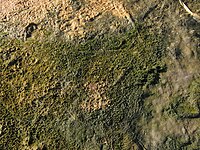
Photo from wikipedia
Methanogenesis and sulfate reduction are important microbial processes in hypersaline environments. However, key aspects determining substrate competition between these microbial processes have not been well documented. We evaluated competitive and… Click to show full abstract
Methanogenesis and sulfate reduction are important microbial processes in hypersaline environments. However, key aspects determining substrate competition between these microbial processes have not been well documented. We evaluated competitive and non-competitive substrates for stimulation of both processes through microcosm experiments of hypersaline microbial mat samples from Guerrero Negro, Baja California Sur, Mexico, and we assessed the effect of these substrates on the microbial community composition. Methylotrophic methanogenesis evidenced by sequences belonging to methanogens of the family Methanosarcinaceae was found as the dominant methanogenic pathway in the studied hypersaline microbial mat. Nevertheless, our results showed that incubations supplemented with acetate and lactate, performed in absence of sulfate, also produced methane after 40 days of incubation, apparently driven by hydrogenotrophic methanogens affiliated to the family Methanomicrobiaceae. Sulfate reduction was mainly stimulated by addition of acetate and lactate; however, after 40 days of incubation, an increase of the H2S concentrations in microcosms amended with trimethylamine and methanol was also observed, suggesting that these substrates are putatively used for sulfate reduction. Moreover, 16S rRNA gene sequencing analysis showed remarkable differences in the microbial community composition among experimental treatments. In the analyzed sample amended with acetate, sulfate-reducing bacteria (SRB) belonging to the family Desulfobacteraceae were dominant, while members of Desulfohalobiaceae, Desulfomicrobiaceae, and Desulfovibrionaceae were found in the incubation with lactate. Additionally, we detected an unexpected high abundance of unclassified Hydrogenedentes (near 25%) in almost all the experimental treatments. This study contributes to better understand methanogenic and sulfate-reducing activities, which play an important role in the functioning of hypersaline environments.
Journal Title: Microbial Ecology
Year Published: 2017
Link to full text (if available)
Share on Social Media: Sign Up to like & get
recommendations!